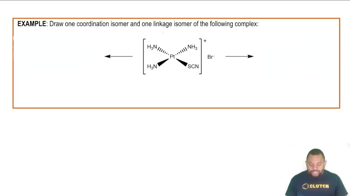Ch.23 - Transition Metals and Coordination Chemistry

Brown15th EditionChemistry: The Central ScienceISBN: 9780137542970Not the one you use?Change textbook
Chapter 23, Problem 45
Complete the exercises below. Determine if each of the following metal complexes is chiral and therefore has an optical isomer: b. octahedral trans-[Ru(bipy)₂Cl₂].
 Verified step by step guidance
Verified step by step guidance1
Identify the geometry of the complex: The complex is octahedral, which means it has six ligands arranged around the central metal ion in an octahedral shape.
Examine the ligands: The complex contains two bidentate ligands (bipy) and two monodentate ligands (Cl).
Determine the arrangement of ligands: In a trans configuration, the two identical ligands (Cl) are opposite each other, and the two bidentate ligands (bipy) are also opposite each other.
Consider the symmetry: A complex is chiral if it lacks an internal plane of symmetry. In the trans configuration, the complex has a plane of symmetry that divides the complex into two mirror-image halves.
Conclude about chirality: Since the trans configuration has a plane of symmetry, the complex is not chiral and does not have an optical isomer.
Key Concepts
Here are the essential concepts you must grasp in order to answer the question correctly.
Chirality
Chirality refers to the geometric property of a molecule that makes it non-superimposable on its mirror image, much like left and right hands. A chiral molecule typically has an asymmetric carbon atom, but in coordination complexes, chirality can arise from the arrangement of ligands around a central metal atom. Understanding chirality is essential for determining whether a complex can exist in two optical isomers.
Recommended video:
Guided course

Chirality
Octahedral Geometry
Octahedral geometry is a common arrangement for coordination complexes where a central metal atom is surrounded by six ligands at the corners of an octahedron. This geometry can lead to different spatial arrangements of ligands, which can affect the chirality of the complex. In the case of trans-[Ru(bipy)₂Cl₂], the arrangement of bipy and Cl ligands is crucial for assessing its optical activity.
Recommended video:
Guided course

Electron Geometry
Optical Isomerism
Optical isomerism occurs when two compounds are mirror images of each other and cannot be superimposed, leading to different optical activities. These isomers, known as enantiomers, rotate plane-polarized light in opposite directions. For a complex to exhibit optical isomerism, it must be chiral, which is determined by the spatial arrangement of its ligands, as seen in the analysis of trans-[Ru(bipy)₂Cl₂].
Recommended video:
Guided course

Isomerism in Coordination Complexes Example
Related Practice
